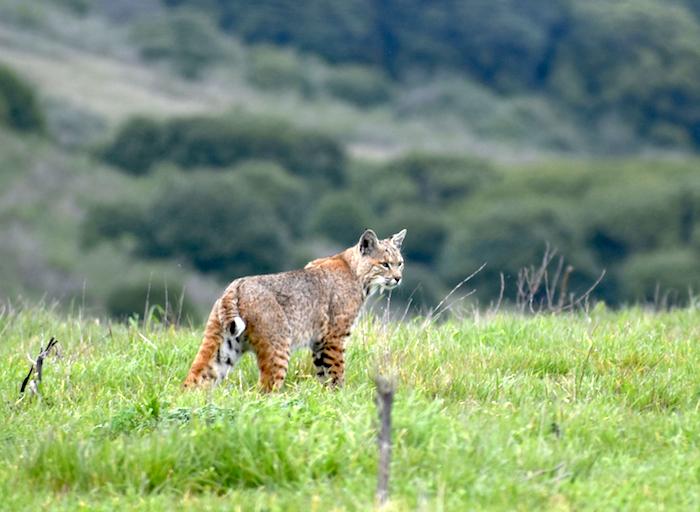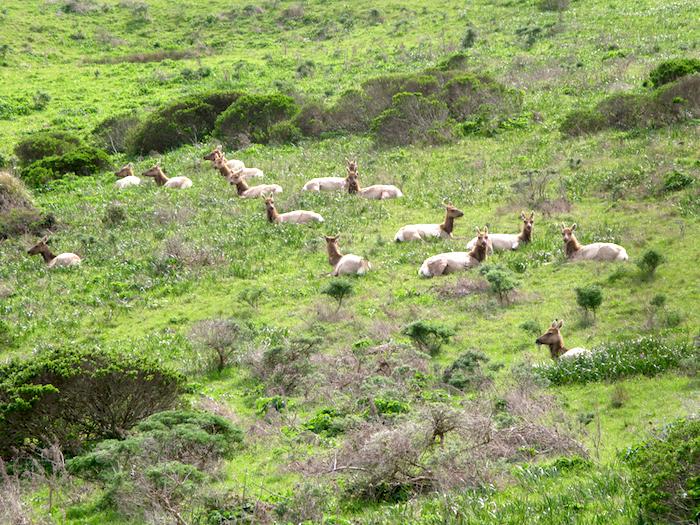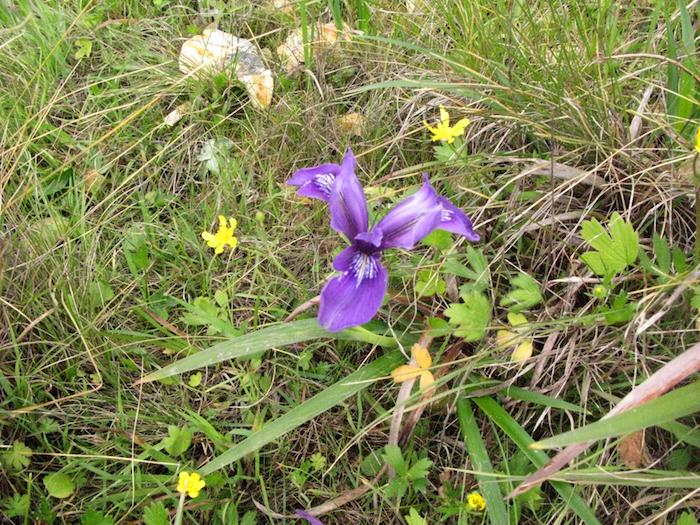
Bobcats still lurk the landscapes of Point Reyes National Seashore and Golden Gate National Recreation Area/Western Watersheds Project
Editor's note: Though California has been heavily developed, there remain places in national parks where you still can spy some of the native flora and fauna. Laura Cunningham, California director of the Western Watersheds Project, points out some of these places.
Hundreds of years ago coastal California was covered with lush grasslands bathed in summer fog and Pacific winter storm fronts, home to giant grizzlies, herds of tule elk, and crossed by creeks running with coho salmon and steelhead trout. Just offshore from the grassy sea cliffs were pods of migrating grey whales, and sandy beaches next to the coastal prairies offered respite to harbor seals, elephant seals, sea lions, and perhaps even fur seals. Bird life was equally diverse.
Much of this prairie and coast habitat is now converted to urban streets, houses, exotic trees, farms, and bay-fill, with little hint of what the landscape was like 200 years ago. Except in certain national park units, where the visitor can still find relicts of these plant communities and the wildlife that roams these landscapes.
What is coastal prairie? Native perennial grasslands growing on moister, cooler coastal hills, bluffs, terraces, and valleys that are influenced by Pacific coastal climates: summer fog and heavy winter rains. Many diverse wildflowers and some shrubs, such as coyote brush and bush lupine, also inhabit this zone. Classically, this plant community was defined as running along the coast of California from northern Los Angeles County into Oregon, although a form of coastal prairie probably occupied the prehistoric southern California coast merging with south coastal sage scrub.
Formerly abundant in an emerald carpet on the sea bluffs and coastal hills and valleys, only relicts of coastal prairies remain now in parks and places where the bulldozers and hungry cattle herds can’t reach.

Idaho fescue, a native northern coastal prairie bunchgrass, can be found continuously from San Mateo County, California, northward/Laura Cunningham
Idaho fescue (Festuca idahoensis) is an important native northern coastal prairie bunchgrass, found continuously from San Mateo County, California, northward. Graceful fountain-like bluish bunches with dense fine blades, these ornamental grasses are found on north- and east-facing slopes and ridgetops swept by summer fog. Beautiful remnants of this type of coastal prairie can be seen in higher ground at Point Reyes National Seashore in Marin County, as at L Ranch on the farthest edges of dairy cattle pastures that are too far for the hungry cows to access from the barns. Large areas of the park unit may have held this species on well-drained uplands, but they are now eliminated by heavy livestock grazing.
Also at Point Reyes National Seashore, bunches of other native grasses can be found in relict areas of roadsides and protected areas where cattle are fenced out: California hairgrass (Deschampsia cespitosa) in meadows, Pacific reedgrass (Calamagrostis nutkaensis), and blue wildrye (Elymus glaucus).
Most of the coastal prairie has been disturbed or eliminated, and is now largely replaced by introduced Mediterranean annual grasses and weeds such as poison hemlock (Conium maculatum). Discovering a native California grassland is a rare event today. But it can be restored. And restoring the coastal prairie will support the incredible wildlife that lives in these native plant communities. These places are already popular for camera safaris and wildlife viewing trips along the wild edge of the Pacific Ocean. There is great potential to increase this wild landscape in our coastal parks.
The Pacific edge prairies are full of biodiversity in national park units, from salmon to salamanders, abundant birdlife, and tule elk--California’s endemic elk subspecies (Cervus canadensis nannodes). Wildlife watching and birdwatching in the coastal prairie habitat can be quite rewarding, and Point Reyes is one of the best places to catch a glimpse of what early California was like in centuries past.
Northern harriers nest in the marshes and wet meadows that still have tall vegetation in low places in the coastal prairie. Colorful Western bluebirds hunt insects among the grasses. Surf scoters can be seen from the coastal prairie out on the sea.

Tule elk are commonly viewed at Point Reyes National Seashore/Laura Cunningham
And the recently state-protected tricolored blackbird visits the coastal prairie on occasion as at Point Reyes. It is threatened by the destruction of marshes, where it builds group nesting colonies. Point Reyes National Seashore still allows the growing of fields of silage -- consisting of wheat, rye, field pea, radish, and mustard used to supplement dairy cattle feed -- that are chosen as a proxy nesting ground on occasion by tri-colored blackbirds, and mowing these silage fields could destroy nesting colonies.
Harbor seals and elephant seals can still be observed as they loaf on beaches next to the coastal prairie.
In one of the few places on the California coast where tule elk can be seen on coastal prairie habitats, a visit in September and October to Tomales Point in Point Reyes National Seashore can take one back in time to primeval early California where bull elk bugle to each other and clash antlers in epic battles during the rut -- a taste of what can be seen in Yellowstone National Park with Rocky Mountain elk -- so close to the metropolitan Bay Area. The potential exists to allow tule elk herds to roam freely in the entire park, giving the visitor an increased opportunity to view wildlife so close to California urban centers.
For some reason, Golden Gate National Recreation Area and Point Reyes National Seashore are some of the best places to view bobcats. These small, elusive wildcats can sometimes be glimpsed on the rolling coastal prairie hills hunting pocket gophers and California voles in broad daylight. The area is famous among wildlife photographers for this reason; few other places in California, or the West for that matter, host such a population of bobcats that stalk their prey along roadsides in open grasslands during the sunlight hours.
These wildlife-viewing opportunities in the coastal prairies that are still in public land ownership offer unparalleled wildlife camera safaris in the Golden State, and every chance for conserving the Pacific prairies should be taken to maintain and restore these habitats.

Douglas Iris Buttercups still bloom at Point Reyes/Laura Cunningham
In California, remnants of coastal prairies can be found in National Park Service units including Redwood National Park, Alcatraz Island, Cabrillo National Monument, Channel Islands National Park, the Presidio of San Francisco, Fort Point National Historic Site in San Francisco, Golden Gate National Recreation Area, and of course Point Reyes National Seashore.
Perhaps not as visually stunning as coastal redwood forests, yet the coastal prairies are full of wildlife and wildflowers, and deserve recognition, conservation, and exploration by everyone who visits national parks.
When hiking and wandering through these remnant coastal prairies, the visitor can imagine a time in the past when not just bobcats but also large California grizzly bears hunted gophers (and elk), a time before the grizzly was only a symbol on the state flag.






Add comment